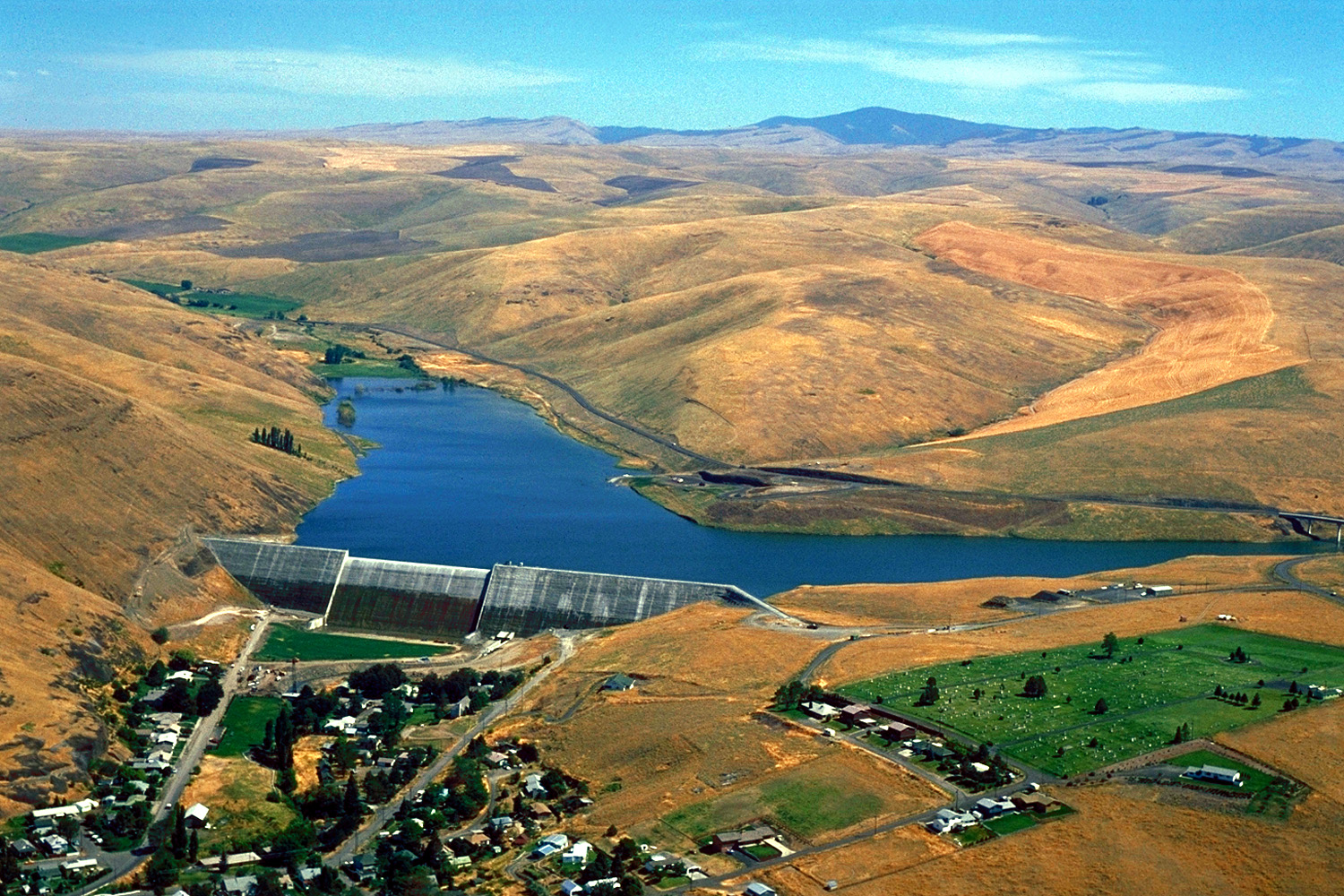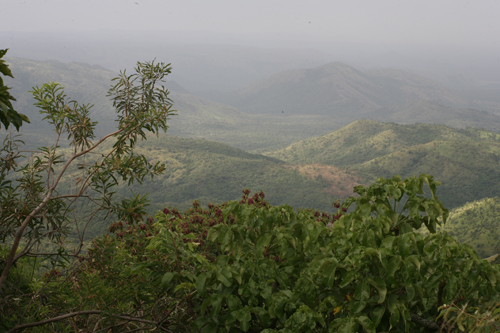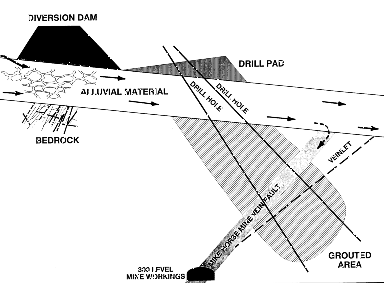|
Roller-compacted Concrete
Roller-compacted concrete (RCC) or rolled concrete (rollcrete) is a special blend of concrete that has essentially the same ingredients as conventional concrete but in different ratios, and increasingly with partial substitution of fly ash for Portland cement. The partial substitution of fly ash for Portland Cement is an important aspect of RCC dam construction because the heat generated by fly ash hydration is significantly less than the heat generated by Portland Cement hydration. This in turn reduces the thermal loads on the dam and reduces the potential for thermal cracking to occur. RCC is a mix of cement/fly ash, water, sand, aggregate and common additives, but contains much less water. The produced mix is drier and essentially has no slump. RCC is placed in a manner similar to paving; the material is delivered by dump trucks or conveyors, spread by small bulldozers or specially modified asphalt pavers, and then compacted by vibratory rollers. In dam construction, roll ... [...More Info...] [...Related Items...] OR: [Wikipedia] [Google] [Baidu] |
Willow Creek Dam (Oregon)
Willow Creek Dam is a dam in Morrow County of the U.S. state of Oregon, located just east of Heppner's city limits. It was the first major dam in the United States constructed of roller-compacted concrete. The dam's drainage basin is of arid rolling hills in the lower basin but with headwaters in the northern Umatilla National Forest. The dam's original purpose was primarily to store water for flood control, but also to serve recreation, fish and wildlife, and irrigation uses. The dam impounds Willow Creek to create Willow Creek Lake. The lake level can be a maximum of elevation and a minimum of for a total usable storage capacity of . History A major flood killed approximately one quarter of Heppner's population in June 1903—about 250 people. The flooding creek flow was as a result of a flash flood caused by thunderstorms, known as the Heppner Flood of 1903. A flood control study was completed in 1962 at a total cost of $219. In 1965, a flood control project was ... [...More Info...] [...Related Items...] OR: [Wikipedia] [Google] [Baidu] |
Concrete Buildings And Structures
Concrete is a composite material composed of fine and coarse construction aggregate, aggregate bonded together with a fluid cement (cement paste) that hardens (cures) over time. Concrete is the second-most-used substance in the world after water, and is the most widely used building material. Its usage worldwide, ton for ton, is twice that of steel, wood, plastics, and aluminum combined. Globally, the ready-mix concrete industry, the largest segment of the concrete market, is projected to exceed $600 billion in revenue by 2025. This widespread use results in a number of Environmental impact of concrete, environmental impacts. Most notably, the production process for cement produces large volumes of greenhouse gas emissions, leading to net 8% of global emissions. Other environmental concerns include widespread Sand theft, illegal sand mining, impacts on the surrounding environment such as increased surface runoff or Urban heat island, urban heat island effect, and potential publ ... [...More Info...] [...Related Items...] OR: [Wikipedia] [Google] [Baidu] |
Concrete
Concrete is a composite material composed of fine and coarse aggregate bonded together with a fluid cement (cement paste) that hardens (cures) over time. Concrete is the second-most-used substance in the world after water, and is the most widely used building material. Its usage worldwide, ton for ton, is twice that of steel, wood, plastics, and aluminum combined. Globally, the ready-mix concrete industry, the largest segment of the concrete market, is projected to exceed $600 billion in revenue by 2025. This widespread use results in a number of environmental impacts. Most notably, the production process for cement produces large volumes of greenhouse gas emissions, leading to net 8% of global emissions. Other environmental concerns include widespread illegal sand mining, impacts on the surrounding environment such as increased surface runoff or urban heat island effect, and potential public health implications from toxic ingredients. Significant research and development is ... [...More Info...] [...Related Items...] OR: [Wikipedia] [Google] [Baidu] |
Asphalt Concrete
Asphalt concrete (commonly called asphalt, blacktop, or pavement in North America, and tarmac, bitumen macadam, or rolled asphalt in the United Kingdom and the Republic of Ireland) is a composite material commonly used to surface roads, parking lots, airports, and the core of embankment dams. Asphalt mixtures have been used in pavement construction since the beginning of the twentieth century. It consists of mineral aggregate bound together with asphalt, laid in layers, and compacted. The process was refined and enhanced by Belgian-American inventor Edward De Smedt. The terms ''asphalt'' (or ''asphaltic'') ''concrete'', ''bituminous asphalt concrete'', and ''bituminous mixture'' are typically used only in engineering and construction documents, which define concrete as any composite material composed of mineral aggregate adhered with a binder. The abbreviation, ''AC'', is sometimes used for ''asphalt concrete'' but can also denote ''asphalt content'' or ''asphalt cement'', ... [...More Info...] [...Related Items...] OR: [Wikipedia] [Google] [Baidu] |
:Category:Roller-compacted Concrete Dams
The category lists dams constructed primarily with roller-compacted concrete (RCC). They include arch and gravity dam A gravity dam is a dam constructed from concrete or stone masonry and designed to hold back water by using only the weight of the material and its resistance against the foundation to oppose the horizontal pressure of water pushing against it. ...s currently proposed, under construction or completed. Dams by type Concrete ... [...More Info...] [...Related Items...] OR: [Wikipedia] [Google] [Baidu] |
Diamer-Bhasha Dam
Diamer-Bhasha Dam is a concreted-filled gravity dam, in the preliminary stages of construction, on the River Indus between Kohistan district in Khyber Pakhtunkhwa and Diamer district in Gilgit Baltistan, Pakistan administered Kashmir. Its foundation stone was laid by the then Prime Minister of Pakistan in 1998. The dam site is situated near a place called "Bhasha", hence the name which is 40 km downstream of Chilas town and 315 km from Tarbela Dam. The eight million acre feet (MAF) reservoir with 272-metre height will be the tallest roller compact concrete (RCC) dam in the world. Upon completion, Diamer-Bhasha dam would (i) produce 4800 megawatts of electricity through hydro-power generation; (ii) store an extra of water for Pakistan that would be used for irrigation and drinking; (iii) extend the life of Tarbela Dam located downstream by 35 years; and (iv) control flood damage by the River Indus downstream during high floods. However, in response to using Basha Dam ... [...More Info...] [...Related Items...] OR: [Wikipedia] [Google] [Baidu] |
Gilgel Gibe III Dam
The Gilgel Gibe III Dam is a 250m high roller-compacted concrete dam with an associated hydroelectric power plant on the Omo River in Ethiopia. It is located about west of Sodo in the Southern Nations, Nationalities, and Peoples' Region. Once fully commissioned, it will be the third largest hydroelectric plant in Africa with a power output of about 1870 Megawatt (MW), thus more than doubling total installed capacity in Ethiopia from its 2007 level of 814 MW.Ethiopian Electric Power CorporatioGibe III Hydroelectric Project Official Website, accessed on May 7, 2012 The Gibe III dam is part of the Gibe cascade, a series of dams including the existing Gibe I dam (184 MW) and Gibe II power station (420 MW) as well as the planned Gibe IV (1472 MW) and Gibe V (560 MW) dams. The existing dams are owned and operated by the state-owned Ethiopian Electric Power, which is also the client for the Gibe III Dam. The US$1.8 billion project began in 2006 and began to generate electricity in Oc ... [...More Info...] [...Related Items...] OR: [Wikipedia] [Google] [Baidu] |
Omo Gibe III, Wolayita 3
Omo or OMO may refer to: Geography Ethiopia * Omo River (Ethiopia), in southern Ethiopia is the largest Ethiopian river outside the Nile Basin and namesake for all the topics below * Omo Nada, one of the woredas in the Oromia Region of Ethiopia * South Omo Zone, a zone in the Ethiopian Southern Nations, Nationalities and Peoples' Region (SNNPR) * Omo National Park, Ethiopia * Omo Kibish Formation, an East African rock formation * Omo remains, a collection of hominid bones Elsewhere *Omo River(Yamanashi) *Omø, an island in Denmark *Omo River (Quebec), a tributary of Maicasagi River in Quebec, Canada People * Omo Osaghae (born 1988), American hurdler * Suleiman Omo (born 1985), Nigerian footballer for clubs in southeastern Europe Acronyms and codes * Open market operation, by the Federal Reserve or other central banks * Open Market Option allows someone approaching retirement to ‘shop around’ * One-man operation (OMO), a bus or tram on which the driver collects the fares ... [...More Info...] [...Related Items...] OR: [Wikipedia] [Google] [Baidu] |
Hydrogen Sulfide
Hydrogen sulfide is a chemical compound with the formula . It is a colorless chalcogen-hydride gas, and is poisonous, corrosive, and flammable, with trace amounts in ambient atmosphere having a characteristic foul odor of rotten eggs. The underground mine gas term for foul-smelling hydrogen sulfide-rich gas mixtures is ''stinkdamp''. Swedish chemist Carl Wilhelm Scheele is credited with having discovered the chemical composition of purified hydrogen sulfide in 1777. The British English spelling of this compound is hydrogen sulphide, a spelling no longer recommended by the Royal Society of Chemistry or the International Union of Pure and Applied Chemistry. Hydrogen sulfide is toxic to humans and most other animals by inhibiting cellular respiration in a manner similar to hydrogen cyanide. When it is inhaled or it or its salts are ingested in high amounts, damage to organs occurs rapidly with symptoms ranging from breathing difficulties to convulsions and death. Despite this, the ... [...More Info...] [...Related Items...] OR: [Wikipedia] [Google] [Baidu] |
Grout Curtain
A grout curtain is a barrier that protects the foundation of a dam from seepage and can be made during initial construction or during repair. Additionally, they can be used to strengthen foundations and contain spills. Characteristics A grout curtain usually consists of a row of vertically drilled holes filled with pressurized grout, a process commonly known as pressure grouting. The holes are drilled in intervals and in such a way that they cross each other, creating a curtain. Method Grout is injected with grouting jets, which use a high-pressure fluid stream (i.e., slurry or water) to erode a cavity in the soil. See also *Levee *Dam failure A dam failure or dam burst is a catastrophic type of structural failure characterized by the sudden, rapid, and uncontrolled release of impounded water or the likelihood of such an uncontrolled release. Between the years 2000 and 2009 more than ... References External linksCurtain Grouting the Georgetown Lighthouse [...More Info...] [...Related Items...] OR: [Wikipedia] [Google] [Baidu] |
American Scientist
__NOTOC__ ''American Scientist'' (informally abbreviated ''AmSci'') is an American bimonthly science and technology magazine published since 1913 by Sigma Xi, The Scientific Research Society. In the beginning of 2000s the headquarters was in New Haven, CT. Each issue includes feature articles written by prominent scientists and engineers who review research in fields from molecular biology to computer engineering. Each issue also includes the work of cartoonists, including those of Sidney Harris, Benita Epstein Benita L. Epstein is a prolific gag cartoonist for magazines, greeting cards, websites and newspapers. She was a regular contributor to the comic strip ''Six Chix'', distributed by King Features Syndicate. Before becoming a cartoonist, Epstein ea ..., and Mark Heath. Also included is the ''Scientists' Nightstand'' that reviews a vast range of science-related books and novels. ''American Scientist Online'' () was launched in May 2003. References External links * ... [...More Info...] [...Related Items...] OR: [Wikipedia] [Google] [Baidu] |







